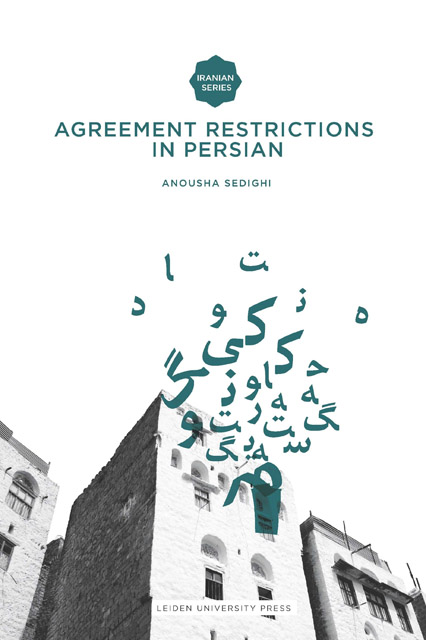Book contents
- Frontmatter
- Acknowledgements
- Table of Contents
- Chapter 1 Introduction
- Chapter 2 Animacy and Agreement Restriction in Persian
- Chapter 3 Psychological Verbs and Multiple Subject Constructions
- Chapter 4 Psychological Verbs in Persian and Applied Arguments
- Chapter 5 Concluding Remarks
- References
- List of Abbreviations
- Backlist Iranian Studies Series
Chapter 4 - Psychological Verbs in Persian and Applied Arguments
Published online by Cambridge University Press: 19 November 2022
- Frontmatter
- Acknowledgements
- Table of Contents
- Chapter 1 Introduction
- Chapter 2 Animacy and Agreement Restriction in Persian
- Chapter 3 Psychological Verbs and Multiple Subject Constructions
- Chapter 4 Psychological Verbs in Persian and Applied Arguments
- Chapter 5 Concluding Remarks
- References
- List of Abbreviations
- Backlist Iranian Studies Series
Summary
Introduction
In this chapter, I explore the constructions in Persian that contain what I call the psychological verbs. They always involve involuntary expressions of psychological/physical states and exhibit agreement restrictions. In order to explain the lack of verbal agreement, I propose that these constructions involve Applicative Heads and Applied Arguments. The principal idea is that unlike the common belief, the experiencer is not a core argument of the verb; rather, it is introduced by a new category of applicative phrase, a Super High Applicative head. In order to have a better understanding of my analysis on the Persian psychological verbs, I first introduce the notion of applicative phrases and then discuss the Persian psychological constructions.
Applied Arguments
Based on earlier works on Bantu languages by Baker (1988a-1996), Bresnan & Moshi (1993), and Marantz (1984-1993), Pylkkänen (2002) introduces the notion of an Applicative head as a syntactic head whose function is to license an argument DP (applied argument) which is not a true argument of the verb. Pylkkänen argues that cross-linguistically, there are two kinds of applicatives that are differentiated by the type of complement they take (Marantz 1984, Baker, 1988, Pesetsky, 1995, among others); The high applicatives where the applicative head denotes a thematic relation between an individual and an event, and the low applicatives, where the applicative head denotes a transfer of the possession relation. The structures are shown in (172).
As previously mentioned, Pylkkänen (2002) argues that the high applicatives relate a DP to an event. They license the applied argument DP in a position external to the vP. The structure in (172) contains a VoiceP and the subject is located in its spec (Kratzer 1996). It is argued that the high applicative head and voice both add a participant to the event by being added to the event vP. An example of a high applicative with a static verb in Albanian is in (173) with the syntactic tree presented in (174).
(173) Agimi I mban Drites çanten time
A.NOM DAT.CL holds Drita.DAT bag.ACC my
Agim holds my bag for Drita
(Pylkkänen 2002: 26)In (173), the applied argument Drita is a benefactive licensed by an applicative head below VoiceP where the nominative argument is introduced. The structure is in (174).
- Type
- Chapter
- Information
- Agreement Restrictions in Persian , pp. 77 - 120Publisher: Amsterdam University PressPrint publication year: 2010

